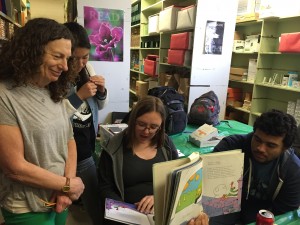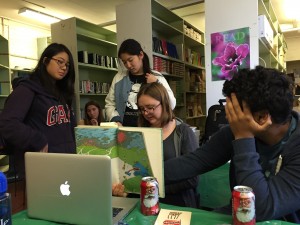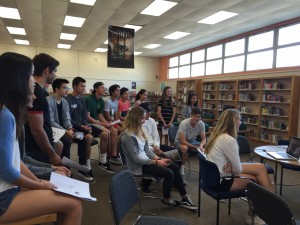Here are some of the library highlights since we returned from our Ski Week break:
#WRAD16
February 24 was “World Read Aloud Day.” Every year World Read Aloud Day calls global attention to the importance of reading aloud and sharing stories. For several years now, librarians have been connecting students via Skype and Google Hangouts to other schools to meet each other and to read and be read to. This year, many libraries chose to celebrate all week in order to expand the options to connect. Two amazing librarians, Shannon Miller and Andy Plemmons, set up a Google Doc we could use to make connections. Scheduling sessions across different time zones can be a challenge, but our library made two matches. Our Library Club President Danit Rich read Dr. Seuss’s The Lorax to a 1st Grade class at Punahou School in Hawaii, and William Brown’s International English class read C. Alexander London’s New Day, New Friends to a Kindergarten class at Searington Elementary School in Albertson, NY. Our students were awesome!
Unfortunately, we had some tech issues connecting with Punahou, so, while we did get to read, and the 1st graders enjoyed it, there wasn’t enough time to visit as well. For the Kindergarten class, our students all got to introduce themselves, share what country they are from and how it compares with where we live, and to each read a page from the book.
And here are some photos from the library club reading:
Here is a recording of a portion of William Brown’s students reading and visit, plus some photos:
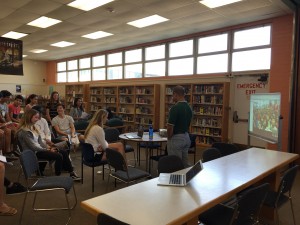
Research
Laura Clarke’s Freshmen English classes visited the library the week of February 22 for five days of research related to topics that will provide background information for their study of Romeo and Juliet. We explored different databases and print books and recorded citations and notes in EasyBib, with all the needed links set up in Google Classroom. We also talked about how to find copyright-friendly images for their presentations and how to credit them. Her 10th grade classes, that visited before the break to do research on topics related to Romanticism, returned on February 26 for a lesson similar to her Freshman students on finding and crediting images in their presentations. Then, they all made good progress preparing their presentations.
Stacy Cabrera’s 11th Grade English students spent four days in the library doing research for their Capstone project comparing two different literary works. We talked about how to find research material in Artemis Literary Resources, a literature research database available to us from the Los Angeles County Library system, about our own subscription databases as resources, about evaluating websites for quality, and note-taking and citations in EasyBib.
Greg Kloes’s 11th Grade U.S. History students visited the library for three days of research in preparation for creating their own magazines on different themes depicting the 1920s. We explored useful database sources for information and websites for finding photos and other images from the time using this library website link: bit.ly/historicalimagesources
SWVBC Afterworlds Discussion
The Library Club participated in its monthly Google Hangouts on Air book discussion with our “Somewhat Virtual Book Club” network of school libraries from around the country. This month’s discussion was of Afterworlds by Scott Westerfield. Here’s the recording of our discussion:
As always, the discussion was lively and participants shared what worked and didn’t work for them in the book.
3D Design and Printing
Our two 3D printers seem to be running non-stop these days! Over the last two weeks, I have been printing projects for Kate Martin and Amber Dixon’s Art 2 students as well as Bharathi Singh’s Algebra 2 students. The Art students used these instructions – bit.ly/2Dto3Dprint – to draw a design with a sharpie and then convert it to 3D in Tinkercad. The Math students did a very similar assignment; they drew a design with a sharpie, but with the requirement that it be a linear, quadratic, or cubic function and its inverse. And, on Thursday and Friday, the Robotics students visited to learn about how 3D design and printing work. Then, they worked on a project, also converting a design from 2D to 3D. The variation in their assignment from the Art and Algebra 2 students was that they created their initial design with Scratch, a graphical programming language, rather than drawing it.

These similar projects for students in very different subjects demonstrates how cross-disciplinary the process of learning about and creating 3D designs is. Our 3D printers are truly helping to break down artificial subject area barriers.
Here are just a few examples of the recent work we have printed:
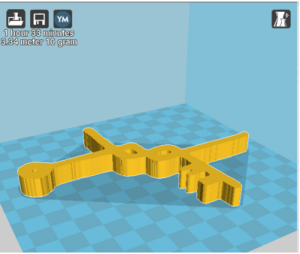
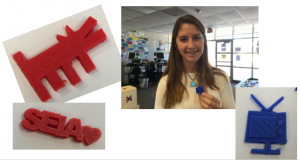
I also printed a set of conic section objects that make up a cone at the request of Christine Baral for her students:
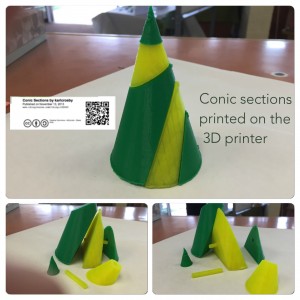
This design came from Thingiverse, a great site for finding and sharing 3D design ideas. These sections will enable students to actually hold and examine objects they normally have to mentally visualize from 2D illustrations.
This week, we will be printing the Robotics class assignments, and the students will be coming back March 10 and 11 to work on the same chess piece assignment the Computer Science students recently completed.
Valentine Serenades
Finally, I was flabergasted and tickled to receive not one, but two, Valentines Serenades from Mira Costa’s talented singers. The first video is from the a cappella serenade; the second is from the Sax Pax. Many thanks to these amazing students!
